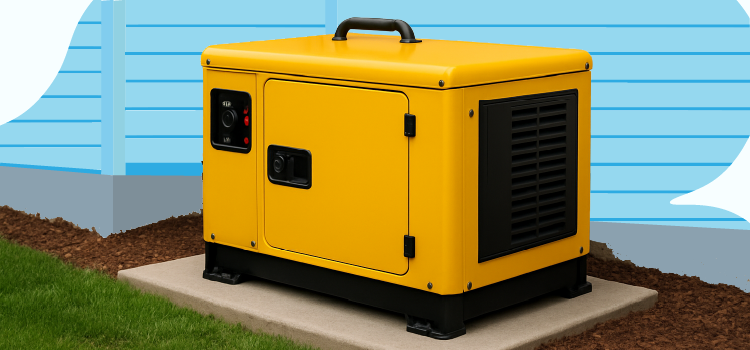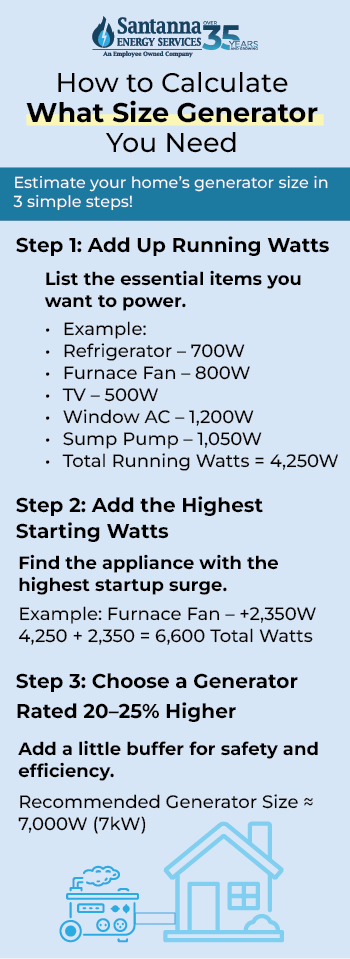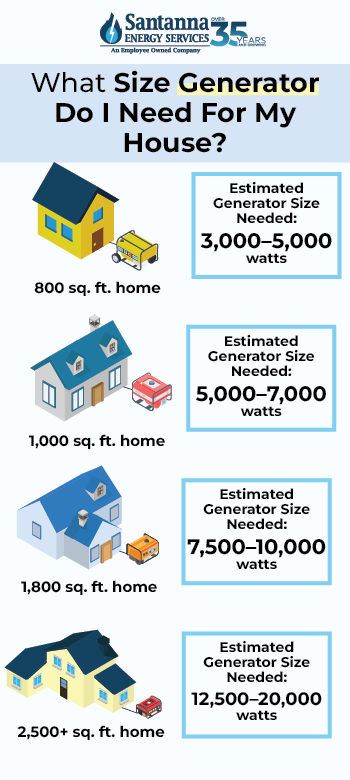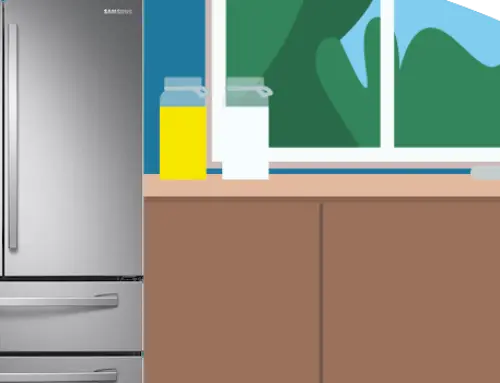What Size Generator Do I Need for My House? A Midwest Homeowner’s Guide
by Tyler Castle
18 min read

The power flickers, the lights go out, and suddenly your house is quiet. You wonder: Will the food in the fridge spoil? How long before the furnace shuts down? Do I really have the right size generator to keep everything running?
If you've felt that mix of frustration and confusion, you're not alone. For Midwest homeowners, power outages caused by ice storms, summer thunderstorms, or even grid strain are a part of life. And while a generator can bring peace of mind, figuring out what size you actually need isn't always straightforward.
As energy experts with over 35 years of experience as an electricity supplier, we've seen it all and know how important it is that you have the right size generator to keep your home going.
This guide will break everything down—step by step. From calculating your home's wattage needs, to understanding your fuel options and safety tips, you'll get clear, practical answers to find out exactly what size generator you'll need for your house. Let's get started!
Key Points of This Article:
- Most homes typically need between 5,000 and 7,000 watt generator for basic coverage, while whole-house systems may require 15,000 watts or more.
- To determine what size generator you need for your house, calculate the total running wattage of the appliances you want to power and add the highest starting wattage among them—then choose a generator rated about 20–25% higher to ensure safe and efficient operation.
- Choosing the right generator size is crucial: a unit that’s too small can overload and damage appliances, while one that’s too large wastes fuel and money.
How Does a Home Generator Work?
A home generator works by creating electricity on demand when the power goes out. With the absence of electricity, a generator runs on fuel like natural gas, propane, or diesel to power the engine inside the unit.
When powered, that engine spins a part called an alternator, which produces electricity. With a portable generator, you plug in appliances directly into the unit.
A standby generator, on the other hand, is installed outside your home and wired into your electrical panel, so it automatically turns on when the grid fails. In simple terms, the generator steps in to keep your essentials like your fridge, furnace, sump pump, and lights running until utility power is restored.
We learned that having a generator is not just a luxury, it’s common sense. In an internal survey at Santanna Energy Services, 21% of our employee-owners said they already use a generator to protect their homes during power outages.
Why Does Sizing Your Generator Correctly Matter?
Choosing the right size generator is one of the most important steps in preparing for power outages. A generator that’s too small won’t be able to handle the load of your essential appliances. A generator that’s too small can cause breakers to trip, can shut down unexpectedly, or even damage sensitive electronics.
On the other hand, buying a generator that’s much larger than what you need isn’t just more expensive upfront, it also burns more fuel and may run inefficiently if it’s not working close to its capacity.
The general rule for generator sizing is simple: calculate the total wattage of the appliances you want to run, then choose a generator rated about 20–25% higher. That extra cushion accounts for “starting watts,” which is the temporary surge of electricity appliances like refrigerators, furnaces, or air conditioners need when they first turn on.
For example, if your essential appliances add up to 5,000 running watts, you don’t want a 5,000-watt generator. You’ll need something closer to 6,000–6,500 watts to safely handle startup surges and avoid overloading the machine.
What To Look For Before Choosing a Generator
Before you spend money on a generator, it’s important to match the right system to your home and lifestyle. Generators are not one-size-fits-all, and choosing wisely now can save you headaches, wasted money, and even safety risks later. Here are the main things to think about:
1. Choose Between Essentials-Only or Whole-Home Coverage
Ask yourself what really needs to stay on during an outage. For some households, that might just be the refrigerator, sump pump, and a few lights.
For others, especially families with kids, medical equipment, or people working from home, keeping the furnace, internet, and more running may be a must. Deciding this up front helps you size your generator correctly and avoid overspending.
2. Consider the Fuel Type That’s Available in Your Area
Generators can run on gasoline, propane, natural gas, or diesel but not all fuels are equally convenient. In rural parts of Michigan or Ohio, propane tanks may be the easiest option.
But in other parts of the U.S., like in the Illinois suburbs, natural gas lines are often the most reliable because you don’t have to worry about refueling. Gasoline is common but harder to store long-term. Think about what’s easiest and safest for you to access during a long outage.
3. Think About Your State’s Typical Outage Length
Not all outages are created equally. Think about how often your area experiences power outages.
In parts of Pennsylvania and Michigan, ice storms can knock out power for days. In Ohio or Illinois, many outages last only a few hours. If your area experiences frequent long outages, you may want a standby generator that can run continuously. If outages are rare and short, a smaller portable unit might be enough.
4. Factor in Your Budget for Upfront and Ongoing Costs
Portable generators can cost a few hundred dollars, while standby systems can start at $3,000 up to $10,000 or more and it varies by the size or running wattage of the generator and the number of circuits it powers.
But the costs don’t end with the purchase of just your unit. Fuel, oil changes, and maintenance all add up. Be realistic about what you’re willing to spend both now and later. Sometimes it’s better to get a slightly larger unit than risk damaging an undersized one, but don’t overshoot if you’ll rarely use it.
5. Remember Your Local Restrictions (Noise, Placement, Permits)
Generators can be loud, and many towns or homeowner associations (HOAs) set rules about where you can place them and how close they can be to neighboring homes.
There are also safety codes that require minimum distances from windows, doors, and vents to prevent carbon monoxide buildup. In some Midwest cities, you’ll need a permit for a permanent standby generator installation. Checking these requirements ahead of time saves you costly changes after you’ve bought your system.
What Size Generator Do I Need for My House?
The size generator you need for your house depends on how many appliances you want to power and their total wattage. Most homes need a generator rated between 5,000 and 7,000 watts to cover basic essentials like lights, refrigerator, sump pump, and furnace fan. Larger homes or those wanting whole-house coverage may need 15,000 watts or more.

Calculating what size generator you need for your house requires a little bit of math and some knowledge about electricity use. But don’t panic, that’s what us energy experts are here to help you with!
In short, the right generator size depends on how much power your home actually uses and the power consumption of each appliance you’re looking to power with your home generator.
To start calculating what size generator you’ll need, it’s helpful to understand that every appliance has two wattage numbers: running watts, which is the steady amount of electricity needed to keep it operating. And starting watts, which is the extra surge of power needed to turn on the appliance. Factoring these numbers into your estimate helps you determine the total power demand your generator needs to handle.
To figure out the total generator size you’ll need to power your home, start by adding all the running watts for the appliances you want to power.
For example, let’s say you want to power a refrigerator (700 watts), furnace fan (800 watts), TV (500 watts), window AC (1,200 watts), and sump pump (1,050 watts). The total running watts would add up to 4,250 watts to power.
Next, find the single highest starting watt requirement from the list of appliances you’re looking to power. This ensures that even at your highest running appliance has to run at maximum power, your generator is strong enough to handle it.
From our example above, the highest starting watts among our appliances is the furnace fan at 2,350.
Lastly, to get an estimated size for your home generator, add your total running watts and your highest starting watts together to get your total power requirement. That means you’d need a generator that can handle around 6,600 total starting watts.
In other words, for this setup, you’d want to look for a generator rated at about 7,000 watts (7 kW) to ensure reliable performance and a little extra power buffer for efficiency losses or smaller household items you may add later.
Once you know your total wattage, here’s how that usually translates into generator sizes for homeowners:
- Smaller generators (5,000–8,000 watts): Cover essentials like lights, refrigerator/freezer, sump pump, and fans. Affordable and portable, but won’t power everything.
- Larger generators (15,000–30,000 watts): Whole-house coverage, including central AC, water heater, kitchen appliances, and all outlets. More expensive but provide full comfort during long outages.
The key is to decide what you must have during an outage. If your goal is just to protect food, prevent flooding, and keep warm, a smaller unit is fine. If you want life to feel “normal” even when the grid is down, you’ll need the power of a larger standby generator.
Looking to skip the math? We get you! Here's an estimate of what size generator you'll need for your home based on home size and the appliances you'll need to power:
What Size Generator Do I Need For My House Chart
| Household Type | Approx. Home Size | Typical Essentials | Estimated Generator Size Needed |
| Single Person | 800 sq. ft. | Lights, refrigerator, phone chargers, small heater or fan | 3,000–5,000 watts |
| Couple (No Kids) | 1,000 sq. ft. | Refrigerator, lights, TV, small appliances, sump pump | 5,000–7,000 watts |
| Family of 4 | 1,800 sq. ft. | Refrigerator/freezer, sump pump, furnace blower, lights, microwave, TV | 7,500–10,000 watts |
| Extended Family | 2,500+ sq. ft. | Whole-home needs: central AC, furnace, water heater, multiple large appliances | 12,000–20,000+ watts |

Types of Generators and Their Capacity Ranges
Still wondering which model is right for you? Not every home needs the same size generator. The right type depends on whether you want to power only essentials or keep your whole house running like normal. Here are the main options for homeowners:
1. Portable Generators or Smaller Generators (5,000–8,000 watts)
Portable generators are smaller, gasoline or propane-powered units that you set up and start manually. A portable generator in the 5,000–8,000 watt range can usually cover essential items like lights, a refrigerator, a sump pump, and fans.
They’re affordable, widely available, and good for short outages, but they need regular refueling, safe outdoor placement, and they won’t cover your entire home.
2. Standby Generators or Larger Generators (15,000–30,000+ watts)
Standby generators are larger systems that are permanently installed outside your home and wired into your electrical panel. They run on natural gas or propane and start automatically within seconds of an outage.
A standby generator in the 15,000–30,000 watt range can handle whole-house power, including central AC, heating systems, water heaters, and large kitchen appliances. They cost more upfront but provide seamless comfort and reliability during long outages.
3. Inverter Generators (1,000–4,000 watts)
Inverter generators are smaller, lightweight versions of portable units. They’re fuel-efficient, quiet, and safe for sensitive electronics like laptops, phones, and medical devices.
However, their lower wattage means they can’t run large appliances or heating and cooling systems. They’re best as a supplement or for very limited backup needs.
How To Calculate What Size Standby Generator You’ll Need
If you’re interested in purchasing a standby generator, figuring out what size you’ll need is similar to that of an essentials only generator.
For this estimate, you’ll want to add up the running watts of all the appliances you want to power then identify the single appliance with the highest starting watts and add that number up with your total wattage of all the appliances you’re looking to run.
For standby generators, you’ll want to factor in a little more power. Consider adding an extra 20–25% to give your generator a safety buffer.
For example, let’s say the running watts of all your essential appliances add up to about 3,000 watts. The appliance with the highest starting watts adds another 2,000 watts, bringing the total to 5,000 watts. To avoid overloading and give your generator room to work efficiently, you’ll want to add a safety margin of 20–25%. That means the right generator size for this home would be around 6,000 to 6,250 watts.
How Much Does a Home Generator Cost with Installation?
The total installed cost of a whole-home generator typically ranges from $7,000 to $15,000. This price covers not just the generator itself but also the professional installation required to connect it safely to your electrical system.
Several factors influence the final cost:
- Generator unit size and wattage – Larger units that can power an entire home cost more than smaller, essentials-only models.
- Labor and installation fees – Licensed electricians and, in some cases, plumbers are needed for safe setup.
- Fuel source – Natural gas, propane, diesel, or gasoline all affect both installation and long-term costs.
- Permits and inspections – Local regulations in the Midwest may require additional approvals, adding to the expense.
On average, the national installation cost is about $7,000, but in the Midwest, labor rates and weatherization needs push that cost about 10–15% higher, or roughly $7,700 to $8,050.
Portable generators remain the most budget-friendly option, often costing just a few hundred dollars. But if your goal is seamless whole-home coverage, expect to spend in the $7,000–$15,000 range for a fully installed standby system.
You may be able to save by looking for manufacturer rebates, seasonal discounts, or service bundles that include installation and long-term maintenance.
While the upfront investment is significant, most Midwest homeowners consider it worthwhile. A standby generator provides reliable power during outages, protecting your home from frozen pipes, spoiled food, and costly disruptions.
Fuel Options for Your Home Generator: Which Is Best for Midwest Homes?
| Fuel Type | Availability | Runtime | Storage | Cost per Hour | Best For |
| Gasoline | Easy to find in towns and cities, but stations may be closed in extended outages | 8–12 hrs per tank (portable units) | Short shelf-life (3–6 months without stabilizer) | Higher than propane/natural gas | Occasional, short outages; portable backup |
| Propane | Common in rural areas; delivered by local suppliers | 24+ hrs with a larger tank | Unlimited shelf-life, won’t degrade | Moderate; delivery adds cost | Rural homes, long outages, cold climates |
| Natural Gas | Available in most cities/suburbs with utility hookups | Unlimited, as long as service is intact | No storage needed | Lower and stable | Whole-home standby in urban/suburban Midwest |
| Diesel | Widely available, often used on farms or commercial sites | Long runtimes, efficient | Long-term with additives; requires care | Moderate–high, varies with market | Large homes, farms, or heavy-duty needs |
Source: Midwest Generator Solutions
How To Hook Up a Generator to Your House
Hooking up a generator isn't as simple as plugging it into a wall outlet. In fact, doing that (called "backfeeding") is dangerous and illegal. To safely connect a generator to your home, you need the right equipment and setup. Here's what every homeowner should know:
1. Use a Transfer Switch
A transfer switch is a special device that connects your generator to your home's electrical panel. It makes sure the power from the generator flows safely into your home's circuits without sending electricity back into the utility lines (which could endanger utility workers).
Transfer switches are required by the electricity code for standby generators and strongly recommended for portable ones.
2. Choose the Connection Type
Portable generators usually connect through a manual transfer switch and a heavy-duty outdoor power inlet. You'll start the generator, flip the transfer switch, and then power your chosen circuits.
Standby generators on the other and are permanently installed and wired directly into your electrical panel. They use an automatic transfer switch that flips on as soon as an outage occurs, restoring power within seconds.
3. Hire a Licensed Electrician
Even though smaller portable generators may feel DIY-friendly, the safest way to hook up any generator to your house is to hire a licensed electrician. They'll install the transfer switch, check load capacity, and make sure your setup meets local building codes.
Bottom line: To safely hook up a generator to your home, you need a transfer switch and professional installation. Standby systems handle this automatically, while portable generators require a manual process. Either way, safety should always come first.
Safety Tips for Using Your Home Generator
Generators can be lifesavers during a power outage, but they also come with serious risks if used the wrong way. Following a few simple safety steps will protect your home, your appliances, and your family.
- Never Run a Generator Indoors: Portable generators produce deadly carbon monoxide gas. Always place them outside, at least 20 feet from windows, doors, and vents. Never run one in a garage, basement, or enclosed porch even with doors open.
- Use a Transfer Switch: A transfer switch connects your generator safely to your home's electrical system and prevents dangerous "backfeeding" into utility lines. Backfeeding can cause fires or injure utility workers trying to restore power.
- Keep Generators Dry: Don't run your generator in rain or snow without a proper cover or canopy. Water and electricity don't mix—moisture can damage the generator and increase the risk of shock.
- Don't Overload the Generator: Know your generator's wattage limits. Plugging in too many appliances can trip the system or damage sensitive electronics. Use surge protectors for added safety.
- Store Fuel Safely: Gasoline, propane, or diesel should be stored in approved containers, away from living areas. Let the generator cool before refueling to prevent fire hazards.
- Maintain Good Ventilation: Even standby generators installed outside should have clear space around them. Keep shrubs, snow, and debris away from vents to ensure safe airflow.
- Schedule Regular Maintenance: Check oil levels, change filters, and run your generator monthly to keep it in good working condition. A poorly maintained generator is more likely to fail when you need it most.
FAQs
What's the difference between watts and amps?
Watts and amps are two ways of measuring electricity, but they describe different things. Watts measure the total power an appliance uses, while amps measure the amount of electrical current flowing through the wires. The two are connected by volts: watts = volts × amps.
What's the difference between resistive and reactive loads?
Appliances use power in different ways. Resistive loads, like lightbulbs, toasters, or space heaters, draw a steady amount of electricity while they're on. Reactive loads, like refrigerators, sump pumps, or air conditioners, need a burst of extra power to start their motors or compressors before settling back to a lower running level. This is why generators must be sized to handle both steady running watts and temporary startup surges.
Can I run my generator in the garage?
No. Running a generator indoors or in a garage is deadly due to carbon monoxide. Always use outside, at least 20 feet from doors and windows.
What's the quietest generator for home use?
Inverter generators are the quietest, often 50–60 decibels (like normal conversation).
Can I plug my generator into my house without a transfer switch?
No. Plugging directly into a wall outlet (backfeeding) is unsafe and illegal. A transfer switch is required to connect safely.
Can I install a generator myself, or do I need an electrician?
Small portable units can be set up with cords, but whole-home standby generators should be installed by a licensed electrician (and often require permits).
How long can a generator run continuously?
Portable generators typically run for 8 to 12 hours on a full tank of fuel, depending on their size and load. Standby generators, on the other hand, are connected to a larger fuel source like natural gas or propane, so they can run for several days straight as long as fuel is available.
Do generators need oil changes?
Yes. Most need an oil change after the first 20–30 hours, then every 100 hours of use (or annually if unused).
How long do standby generators last?
With proper maintenance, standby units typically last 10–20 years or about 10,000–30,000 hours of use.
How do I know if my generator is overloaded?
A generator is overloaded if it struggles to start appliances, trips its circuit breaker, runs roughly, or causes lights to flicker and dim. Overloading can damage both the generator and your appliances.
Choosing the right generator size isn't one-size-fits-all—it depends on your home size, lifestyle, outage risks, and budget. The best way to start is by making a simple list of the appliances and systems you'll need during an outage, then adding up their wattage to guide your decision.
At Santanna, we know Midwest weather can be unpredictable. And while a generator prepares you for outages, Santanna's Unlimited Energy plans prepare you for everything in between, helping you manage your energy supply costs with stability and predictability, season after season.
* Restrictions apply. Enrollment based upon program eligibility. Customers using more than 125% of normal monthly usage as determined by Santanna may be required to switch plans.
Tyler is an experienced energy professional, having worked for Santanna Energy Services, for the past four years. He is passionate about renewable energy and believes that diversifying the energy grid is the key to a sustainable future. Tyler is dedicated to supplying consumers with the best possible energy solutions and works diligently to make sure that Santanna can deliver the highest quality service.







